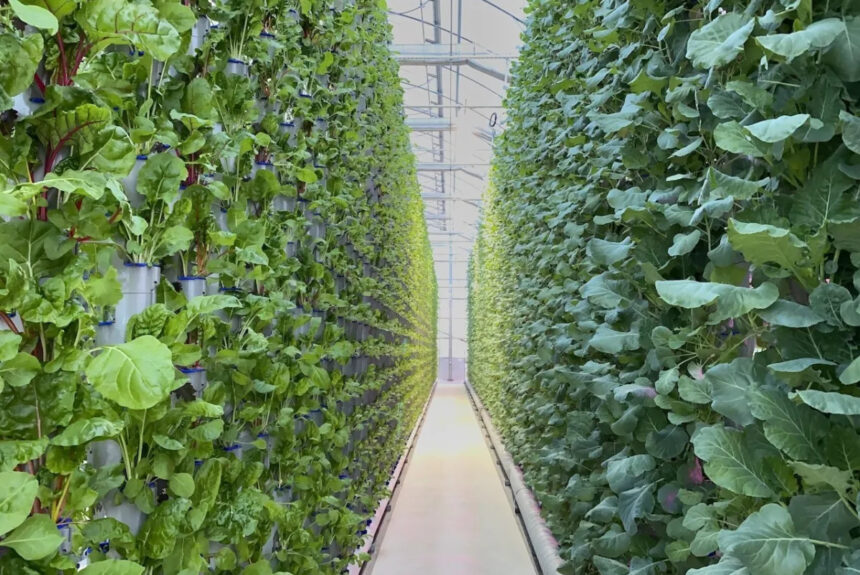Inflation, congested supply chains, and high energy prices are increasing the cost of food around the country. These costs are also straining farmers, who are dealing with high capital costs and workforce shortages. Thankfully, innovative American companies are stepping up to provide solutions to deliver affordable and healthy foods to consumers. One such company is Eden Green.
>>>READ: The Country’s First Carbon-Neutral Food Company
Started in 2017 by two South African brothers who wanted to “grow greens [as] it would look like in the Garden of Eden,” Eden Green is quickly becoming a major player in the sustainable agricultural space.
Eddy Badrina, CEO of Eden Green, recently joined Drew Bond as a part of C3’s Tech Voices interview series to discuss how the company is looking to support and revolutionize American produce production.
Eden Green is on a mission to make America’s food system more sustainable. Currently the majority of the leafy greens grown in the U.S. come from California’s Salinas Valley or Arizona. This means that leafy green lovers on the East Coast are eating a “3,000-mile salad every day,” according to Badrina, who also said, “That’s just not sustainable financially with supply chain and trucking problems and environmentally.”
Traditional greenhouses can also play an important role in bringing produce to the dinner table, but face their own series of limitations.
“While they are more efficient than the farmland in California, use less water, use less land, and produce less waste, the reality is that greenhouses are still huge and they don’t solve the supply chain problem because you still have to truck their food from miles away,” Badrina pointed out. “They also don’t solve the workforce problem because they have to build these huge greenhouses in rural areas where land is cheaper, and you can’t find people to work there. So they’re efficient but huge.”
Indoor farms, which are having their own moment, solve parts of the supply chain problem because they can be placed near high population areas, but have huge long-term capital costs and require a lot of energy to operate.
Eden Green’s facilities are threading the needle: producing enough food to feed dense population areas without needing a large environmental footprint. The greenhouses combine the verticality of indoor farms with the efficiency of traditional greenhouses. While it may seem like a simple solution, only Eden Green has found a way to make it commercially viable.
“[It] sounds really simple, which it is, but it’s so complex at the same time that it’s patented. No one else can do what we’re doing. Most of our peers are growing in greenhouses, so they grow in flat-tray automated greenhouses. They use all of the elements of sunlight, so there’s energy efficiency, but the problem is that it requires vast amounts of land.”
Importantly, Eden Green’s greenhouses allow food to be grown year-round. They can also be easily incorporated into existing agricultural operations, which can improve yields and income for farmers. As Badrina stated, “For them to partner with us and to be able to put one of our greenhouses in their market doesn’t hurt them because then they can free up those 40, 50, 60 acres that they would have devoted to leafy greens or lettuce, they can devote that land to things that are more higher margin for them.” Badrina did emphasize the importance of traditional farming, pointing out that Eden Green’s technology is not a “silver bullet, but rather a part of the solution.”
>>>Listen to more interviews with sustainable business leaders here
Another way in which Eden Green is innovating the U.S. ag system is through what it is growing. Indoor farms primarily grow tomatoes and strawberries because they are in high demand and are easy to profit from. Eden Green, however, is focusing solely on leafy greens. This gives it an opportunity to tap into an $8 billion market (in the U.S. alone), and to cultivate a harvest that has good margins, which is attractive to investors.
Eden Green’s produce could soon be coming to a grocery store near you. After successfully running a 40,000-square-foot pilot facility, the company is weeks away from completing its first commercial facility in Texas, which will be 70,000 square feet. Badrina’s team has partnered with one of the top five distributors in the country to bring its leafy greens to shelves. Eden Green is also working to bring two more commercial greenhouses to market. They will also be in Texas.
Consumers are demanding affordable and healthy food options. Thanks to Badrina’s leadership and Eden Green’s innovative solutions, Americans will soon be able to enjoy sustainably sourced U.S.-grown produce year round.
The views and opinions expressed are those of the author’s and do not necessarily reflect the official policy or position of C3.
